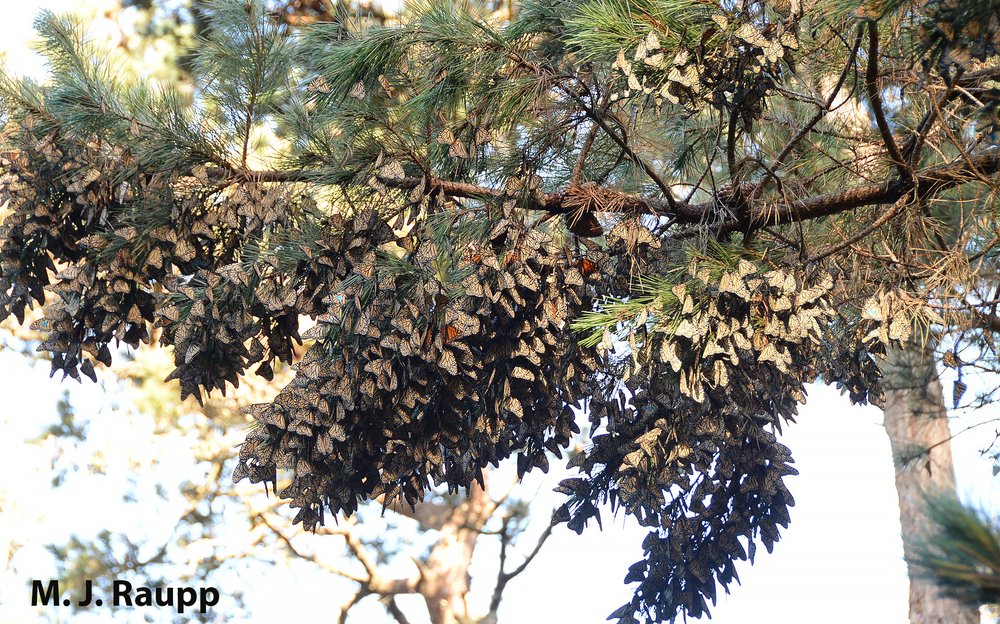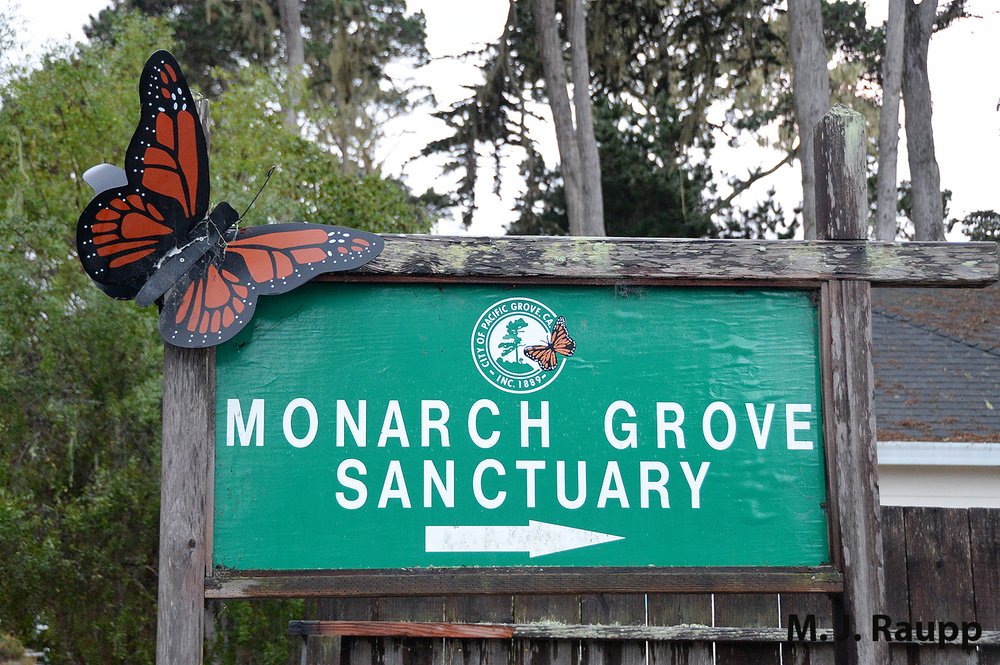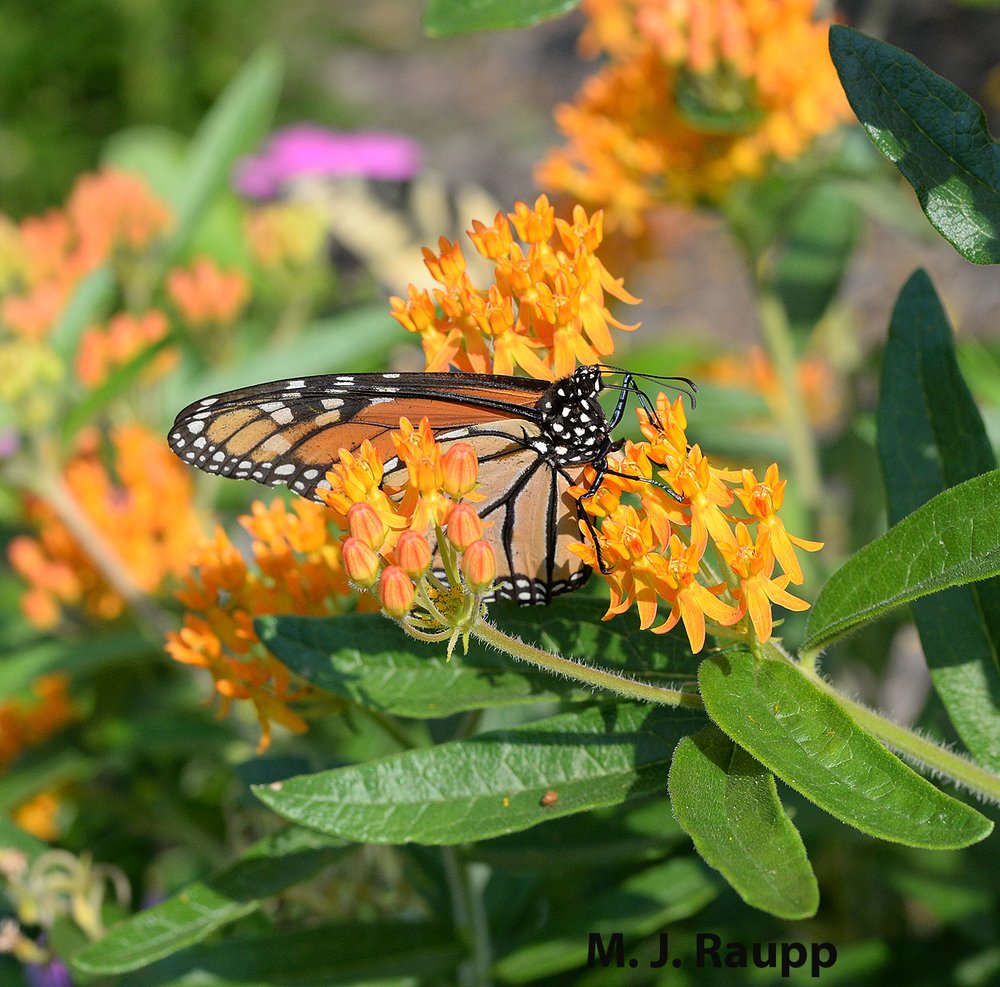
Western monarch butterflies cluster on a Monterey Pine in the Monarch Sanctuary at Pacific Grove, California.

The Beavertail lighthouse at Beavertail State Park in Rhode Island is a great place to watch Eastern migratory monarchs heading south to their overwintering grounds in Mexico.
A recent road trip took Bug of the Week to Beavertail Lighthouse, iconic guard to the entrance of Narraganset Bay, Rhode Island. This historical lighthouse, located in Beavertail State Park, is a stopover point for eastern migratory monarch butterflies as they wend their way from the northernmost breeding grounds in eastern North America en route to their winter retreats thousands of miles away in the mountains of Mexico. Recently, scientists have added Beavertail State Park to a growing list of locations where monarchs are recorded and tagged to track the movement of these peripatetic wonders. Our arrival late in October missed the peak of the monarch stopover, but during the course of our visit, we watched a dozen or so monarchs heading south across Narraganset Bay. On a windswept afternoon, we were lucky to see one lonely voyager hunker down for a rest in a thicket of forlorn perennial flowers. A recent status report provided by Dr. Paula Shrewsbury of the University of Maryland brings us up to speed on the status of monarchs in North America. Here is the report in its entirety.
The Beavertail Lighthouse at Beavertail State Park in Rhode Island is a great place to watch Eastern migratory monarchs heading south to their overwintering grounds in Mexico.
“Monarch butterflies, Danaus plexippus (family: Nymphalidae), are one of, if not, the most well-known butterflies in North America. There are few children who make it through school without learning the lifecycle of these beautiful and interesting iconic butterflies. There are community science projects and numerous other programs with the goal of monitoring and conserving monarchs. Everyone loves monarchs and rightly so. They have one of the most fascinating lifecycles and migratory behaviors of all insects. In addition, monarch adults provide pollination services and the caterpillars are food for other organisms. Given all of this I think they qualify as a “beneficial” even if the caterpillars make milkweed plants look a little ratty.

If you can, plan a trip to Pacific Grove, California to visit the Monarch Sanctuary to witness one of the greatest wonders of the natural world.
Monarchs have an amazing lifecycle that involves multiple generations and migration across miles. In North America (NA), in general, there are three populations. There is the eastern NA Monarch population that overwinters in Mexico, and in the spring, around mid-March, begins its seasonal migration to the north toward southern Canada traveling a few thousand miles. Monarchs undergo multiple generations during this long journey to Canada. In the late summer–fall months, monarchs begin their migration back to their overwintering habitat in the oyamel fir forests in central Mexico. So basically, the adults that return to the overwintering roost in Mexico at the end of the season are several generations later than those that began the journey (ex. their great, great,… grand-butterflies). There is also a western NA Monarch population (west of the Rockies) that similarly migrates between sites in California and Canada. They overwinter or roost in coastal regions of California, migrate to Canada, and back again to California to overwinter. A few winters ago, in December, I was fortunate enough to visit one of the overwintering roosts of monarch adults in Monterey, CA. A truly amazing site that I recommend you all put on your bucket list to experience. A third, more recently founded population that is non-migratory, is in Florida and Georgia.
You have likely heard discussion regarding monarch butterfly decline – in both the Eastern and Western monarch populations. Scientists studying monarch butterflies implicate several factors that come together to threaten populations of monarchs. Illegal logging of the forests in Mexico has reduced optimal overwintering habitat for monarchs. Weather events associated with climate change also threaten monarchs. In 2002, unusual weather in the mountains of Mexico killed an estimated 75% of monarchs that were overwintering; in 2015-2016, a winter storm killed more than 7%. These weather events killed tens of millions of overwintering monarchs. Within the U.S., Eastern monarchs have lost an estimated 165 million acres of breeding habitat along their migration route northward. Although monarch butterflies feed on nectar from a diversity of flowering plants, monarch caterpillars only eat milkweed foliage. Scientists believe that critical milkweed resources used by caterpillars have been dramatically reduced due to the use of herbicides and genetically modified crops that tolerate direct spraying of herbicides and kill milkweed. Other threats to their populations include habitat fragmentation and destruction, urban development, and pesticides, along with other climate change related phenomena.
What is the status of Monarch butterfly populations now? The 2023 annual accounts of the Eastern monarchs that spend the winter in Mexico showed a 22% decline from 2022 counts. The Eastern monarch populations have declined by around 90% since the mid-1990’s. Western monarchs overwinter in forested groves on the coast of California. Western monarch overwintering “Thanksgiving” counts were conducted from November 11 through December 3, 2023 with a total count of 233,394 butterflies across 256 sites in California. The 2023 Thanksgiving count was slightly lower than the 2022 counts, but similar to those of 2021 (Xerces, Jan. 2024). The 2023 Thanksgiving count was followed by a “New Year’s” count (2024) that indicated the highest seasonal decrease on record, likely due to severe winter storms on the west coast. We will have to wait to see what the 2024 Thanksgiving count shows. The Western monarch overwintering population remains at about 5% of what it was in the 1980’s. Scientists say that monarchs are at risk of extinction in North America.
Amidst the eucalyptus and pines, western monarchs brave the maritime chill on the Monterey peninsula.

Research indicates that milkweeds planted along the perimeter of butterfly gardens had 2.5-4 times more monarch eggs and larvae than those planted in the interior. So, if you want lots of monarch caterpillars and butterflies, plant the milkweeds at the edges of pollinator gardens.
What can be done to help monarchs? Globally, efforts to slow (and hopefully stop) climate change, conservation of food resources for adult and larval monarchs, and improvement of habitats for monarchs will help. Actions to influence policy on climate change, pesticide use, and the placement of monarchs on the Endangered Species Act list will also assist monarchs. At a local level, providing habitat with milkweeds for caterpillars and nectar resources for adults should improve monarch reproduction and survival. There are 73 species of milkweed in the U.S., monarch caterpillars use about 30 of these as hosts. Be sure to consult references to learn what milkweed species work well in your geographic region. Here in Maryland, species including common milkweed (Asclepias syriaca), swamp milkweed (Asclepias incarnata), butterfly weed (Asclepias tuberosa), whorled milkweed (Asclepias verticillata), and poke milkweed (Asclepias exaltata) are good choices. Research has determined that tropical milkweed, Aesclepias curassavica, is not a good choice and can actually be detrimental to monarchs. Adult monarchs feed on nectar from a diversity of plants, but not all nectar is created equally. Consult references to learn what plants provide the best nectar for monarch butterflies and their bloom times. Regional references for milkweed plants can be found at this link https://xerces.org/milkweed and references for monarch nectar plants can be found at this link https://xerces.org/monarchs/monarch-nectar-plant-guides.
Research from the lab of Dan Potter (with student Adam Baker, UKY) shows that garden design is important and suggests how to build more effective monarch butterfly gardens. For example, monarch eggs and larvae were 2.5 to 4 times more abundant in gardens with milkweeds planted around the perimeter as opposed to gardens in which milkweeds were surrounded by or intermixed with the other non-milkweed plants. They also found female monarchs laid significantly more eggs on standalone milkweed plants as opposed to milkweeds that were visually "camouflaged" or physically blocked by adjacent non-milkweed plants. Although planting any milkweed and nectar hosts for monarchs will be helpful, these studies provide guidelines to design gardens that are more effective. Start planning for how to include milkweed and monarch nectar plants in your perennial gardens next spring. We have a critical role to play in conserving these remarkable travelers.”
Research indicates that milkweeds planted along the perimeter of butterfly gardens had 2.5-4 times more monarch eggs and larvae than those planted in the interior. So, if you want lots of monarch caterpillars and butterflies, plant the milkweeds at the edges of pollinator gardens.
Acknowledgements
Bug of the Week thanks Dr. Shrewsbury for granting permission to reproduce her story for this week’s episode. The great study “Configuration and Location of Small Urban Gardens Affect Colonization by Monarch Butterflies” by Adam M. Baker and Daniel A. Potter was a key resource for this episode. Thanks also to Carol and Brian for helping us observe migrating monarchs at Beavertail State Park.
No comments:
Post a Comment